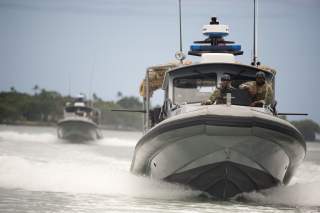Some of the Navy's Smallest Boats are Getting Massive Weapons Upgrades
Think laser-guided weapons.
The Navy is completing a host of sweeping modernization upgrades to its fleet of 14 Patrol Coastal (PC) boats by integrating new laser-guided weapons, communications technology, drone sensors and navigation systems to enable the ships to respond to newly emerging littoral and coastal area enemy attack possibilities.
"This modernization consists of numerous upgrades that support coastal patrol and interdiction surveillance, which are important aspects of littoral operations outlined in the Navy's maritime strategy," Colleen O'Rourke, spokeswoman for Naval Sea Systems Command, told Warrior Maven.
The sweeping PC Boat modernization overhaul is intended to extend the service life of the 1990s-era PC boat fleet into the mid-2020s and beyond. The expected service life of a PC is roughly 30-years, O'Rourke said.
Recommended: America’s Battleships Went to War Against North Korea
Recommended: 5 Places World War III Could Start in 2018
Recommended: How North Korea Could Start a War
Of greater importance than simple service life extension, quite possibly, is that the upgrades are aimed at enabling PCs to keep pace with fast-changing surface threats in areas such as piracy, mines, small boat attacks and potential long-range enemy attacks made possible by drones or modern sensors.
In recent years, the Navy has been arming its fleet of PCs with Raytheon-built Griffin B surface-launched, laser-guided missiles able to hit targets at ranges up to 4 kilometers. The idea is to give the 179-foot long, shallow-water PCs the ability to destroy targets at ranges farther than their on-board guns can reach,
Extended range offensive firepower is intended to give the PCs enhanced surface warfare technology to position the craft for modern surface and shallow water threats. Laser-guided Griffin missiles, reaching what Raytheon developers describe as "beyond gun range," give the boats an ability to strike threats such as swarming small boats at greater standoff distances. The attack capability enhancements, fortified by advanced sensors, better enable PCs to address multiple threats simultaneously or respond to approaching enemy fire more quickly. The Griffin can provide 360-degree coverage for the ship.
The weapons adjustments are particularly well suited for the Navy's 5th Fleet area of operations which covers much of the Middle East including flashpoint areas such as the Straits of Hormuz; tensions with Iranian small boats have at times emerged in some shallower waters near the Iran border which offer an important commercial and military passageway from the Persian Gulf to the open ocean.
The Navy upgrades also include unmanned aerial surveillance systems for 5th Fleet PCs, O'rourke added. This brings the prospect of networking ISR assets with targeting sensors and weapons to improve attack possibilities by relaying targeting information across longer distances. Navy PC boat Mk 52 7.62mm and MK 38 25mm guns are also being upgrade.
The Griffin employs a dual-mode navigational technology using semi-active laser technology and a GPS-aided Inertial Navigation System, according to Raytheon developers.
The weapons upgrade process begins with the installation of the launcher and weapons control system, Forward Looking Infra-Red Systems' BRITE Star II sensor/laser designator, and Raytheon's Griffin B (Block II) missile, Navy officials said.
The 25-foot wide PCs have an eight-foot draft and can reach speeds up to 35 knots. With a crew of 28, the ships are equipped to stay at sea for periods up to 10 days. Many PCs stationed at 5th fleet headquarters in Bahrain are equipped with enhanced communication suites, improved navigation systems and an improved diesel engine control system. They also have two stabilized, electro-optic 25mm gun mounts, Navy officials added.

